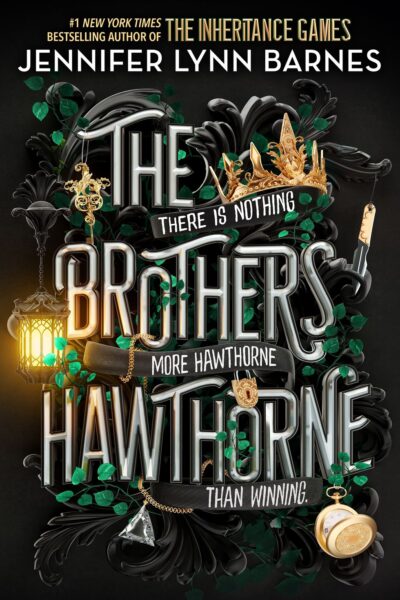
The Brothers Hawthorne
CHAPTER 2: JAMESON
by Barnes, Jennifer LynnThe chapter opens with Jameson Hawthorne and Avery at Iguazú Falls, the world’s largest waterfall system. Jameson is consumed by a sense of hunger—for adventure, for Avery, and for the thrill of danger. Standing on a walkway near the edge of a dramatic drop-off, he teases Avery about daring him to cross the railing, showcasing his reckless charm. Avery, though playful, firmly discourages him, hinting at the tension between his impulsiveness and her caution. The majestic, unstoppable force of the falls mirrors Jameson’s own relentless pursuit of excitement.
Back at their secluded jungle villa, the dynamic between Jameson and Avery shifts to a more intimate tone. Avery presents a coin toss game—“heads or tails”—symbolizing their flirtatious banter and unspoken attraction. Jameson, ever the provocateur, leaves the choice to her, reveling in the anticipation. Their chemistry is palpable as Avery challenges him with a touch and a daring look, suggesting a deeper game with cards. The moment is charged with playful tension, highlighting their complex relationship.
The mood shifts abruptly when a satellite phone interrupts their exchange. The call is from Grayson, Jameson’s brother, confirming they’ve received Nash’s summons—a “nine-one-one” code demanding their presence. Jameson jokes about Grayson’s past reluctance to respond, referencing an embarrassing incident involving leather pants. Despite his teasing, it’s clear the Hawthorne brothers adhere to this ritual without question, emphasizing their unbreakable bond and the consequences of defiance. Avery, ever the mediator, steps in to confirm their compliance, cutting short Jameson’s antics.
The chapter concludes with Avery and Jameson preparing to leave for London, acknowledging the inevitability of responding to the family summons. The interruption underscores the constant pull between Jameson’s desire for freedom and the obligations tying him to his family. Avery’s role as both a grounding force and a willing participant in his adventures is evident, setting the stage for their journey ahead. The blend of danger, intimacy, and familial duty paints a vivid picture of their intertwined lives.
FAQs
1. Comprehension: What is the significance of the “nine-one-one” code among the Hawthorne brothers, and what are the consequences of ignoring it?
Answer:
The “nine-one-one” code is an annual summons each Hawthorne brother can use to request the presence of the others. While it doesn’t indicate an actual emergency, it serves as a binding call for family unity—when one brother texts it, the others must respond without question. Ignoring the summons leads to humorous but embarrassing consequences, as illustrated by Grayson’s past experience of being forced to wear tight leather pants and perform karaoke (page 11-12). This tradition reinforces their familial bonds through playful accountability.2. Analytical: How does the setting of Iguazú Falls reflect Jameson’s personality and his relationship with Avery?
Answer:
Iguazú Falls—described as “unstoppable, off limits, deadly” (page 10)—mirrors Jameson’s adventurous, risk-taking nature. His temptation to test the railing and his hunger for “more” align with the waterfall’s raw power and danger. Avery’s presence as his stabilizing force is evident when she physically restrains him (“Absolutely not”) and removes his teasing focus from the falls to their intimate coin-flip game (page 10-11). The secluded jungle villa further emphasizes their dynamic: while Jameson seeks thrill, Avery grounds him, yet both thrive in their private, untamed world.3. Critical Thinking: Why might the author have chosen to interrupt Jameson and Avery’s moment with Nash’s summons? Analyze the narrative effect.
Answer:
The interruption heightens tension and foreshadows future plot developments. By cutting short their flirtatious card-game proposition (page 11), the summons: (1) reinforces the Hawthorne family’s priority over individual desires, (2) creates urgency that propels the story toward London, and (3) contrasts Jameson’s carefree attitude with Grayson’s stern response (page 12), showcasing sibling dynamics. This abrupt shift also leaves readers curious about Nash’s motives, effectively transitioning from romantic escapism to familial duty while maintaining the chapter’s playful tone through Jameson’s teasing.4. Application: If you were Avery, how would you handle Jameson’s risk-taking tendencies based on this chapter’s events? Justify your approach.
Answer:
Avery’s balanced approach—firm yet playful—proves effective. When Jameson eyes the railing, she physically connects (touching his jaw) and vetoes his dare without stifling his spirit (page 10). Later, she redirects his energy through the “heads or tails” game (page 11), offering controlled excitement. To expand this, I’d establish clear boundaries (e.g., “no waterfall edges”) while channeling his adrenaline into structured challenges (like their card-game tease). This acknowledges his nature while ensuring safety, mirroring how she swaps the satellite phone call’s tension for a decisive plan (“We’ll see you in London,” page 12).
Quotes
1. “Jameson Winchester Hawthorne was hungry—for this, for her, for everything, all of it, more.”
This opening line captures Jameson’s restless, insatiable nature and his intense connection with Avery. It sets the tone for his character’s driven and passionate perspective throughout the chapter.
2. “Staring out at the falls, Jameson felt the lure of more. He eyed the railing. ‘Do you dare me?’ he murmured into the back of Avery’s head.”
This quote exemplifies Jameson’s thrill-seeking personality and his constant push against boundaries. The interaction also showcases his playful dynamic with Avery, who serves as both his partner and occasional restraint.
3. “Heads or tails was an invitation. A challenge. You kiss me, or I kiss you.”
This moment highlights the charged, game-like nature of Jameson and Avery’s relationship. Their interactions are framed as playful challenges, blending romance with competition.
4. “Each Hawthorne brother got a single nine-one-one a year. The code didn’t mean emergency so much as I want you all here.”
This quote introduces an important family dynamic - the Hawthorne brothers’ binding code of loyalty. It foreshadows the summons that will disrupt Jameson and Avery’s idyllic retreat.
5. “‘If you say one word about leather pants,’ Grayson bit out. ‘I will—’ ‘Did you say leather pants?’”
This humorous exchange between Jameson and Grayson reveals their sibling rivalry and establishes Jameson’s tendency to provoke his more serious brother. It provides comic relief while demonstrating family relationships.
